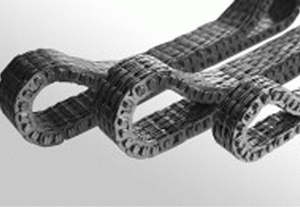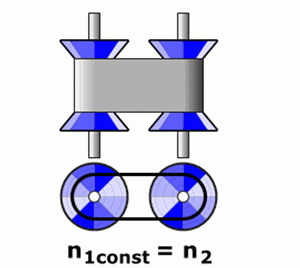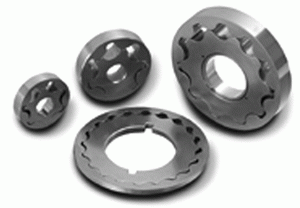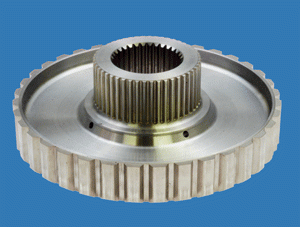CVTs challenge mainstream automotive transmissions
Traditional automotive transmissions use gearboxes which provide a given number of ratios, or speeds. So in a manual gearbox the driver shifts the gears to provide the most appropriate ratio for a given situation and in automatic gearboxes it is the transmission which selects the most appropriate gear, e.g. lowest gear for setting off, middle gears for acceleration and overtaking, and higher gears for fuel efficiency. There can be up to 7 gear ratios or speeds in manual and automatic gearboxes.

Fig. 1 Schematic of the Multitronic CVT developed by Audi in conjunction with LuK GmbH and introduced in 1999 (Courtesy Audi AG)
Increasingly challenging the traditional transmissions is the continuously variable transmission (CVT). CVT technology has been around since the late 1950s when it was introduced into small cars built by the Dutch carmaker DAF. However, these CVTs were found to be unsuitable for engines having more than 100 hp, and the technology was not taken up again until the 1980s when Japanese car manufacturer Subaru offered CVT in its Justy mini-car. Honda introduced CVTs as a transmission option for its Civic HX in the late 1990s, as did Audi AG which launched its Multitronic stepless automatic transmission in late 1999. The Multitronic (Fig. 1 and Fig. 2) was developed jointly with the LuK Group in Germany based on the principles of the CVT popularised by DAF.

Fig.3 The function of the LuK CVT chain is to
transmit power from one pulley set to the other.
The chain consists of several links which are
connected by rocker joints (Courtesy LuK GmbH)
The CVT can continuously vary the ratio between the input shaft and output within a given range, providing virtually an infinite number of possible drive ratios allowing the engine to run at optimum efficiency. The LuK CVT uses a chain drive, an oil-cooled multi-plate clutch (initially of six parts, later of seven to enable it to cope better with the high torque outputs of larger engines) and complex electronics to overcome the traditional shortcomings of CVTs. The function of the LuK CVT chain (Fig. 3) is to transmit power from one pulley set to the other. The chain consists of several links which are connected by rocker joints.
CVT technology still accounts for only a small percentage of all automatic transmissions but it is growing in popularity with an increasing number of car manufacturers having joined Audi and Subaru by introducing CVTs over the past decade. Nissan reports that it alone has well over 1 million cars with CVTs, whilst BMW (Minis), Ford Motor Company, General Motors, Honda, Toyota, and Mitsubishi have also recently introduced CVTs into their vehicles. The new Toyota Super CVT – I is shown in Fig. 4. Renault has equipped its new Fluence car with a CVT transmission.
How does CVT work?
Fig.5 Schematic diagram of chain-driven CVT
(Courtesy Wikipedia)
Although there are several types of CVTs, most cars use a pair of variable-diameter pulleys, each shaped like a pair of opposing cones, with a metal belt or chain running between them (Fig.5 and Fig.6). One pulley is connected to the engine (input shaft), the other to the drive wheels (output shaft). The halves of each pulley are moveable; as the pulley halves come closer together the belt is forced to ride higher on the pulley, effectively making the pulley’s diameter larger. Changing the diameter of the pulleys varies the transmission’s ratio (the number of times the output shaft revolves for each revolution of the engine), in the same way that a 10-speed bike routes the chain over larger or smaller gears to change the ratio.

Fig. 6 An animated image of the principle of the CVT
can be seen on Wikipedia here
Making the input pulley smaller and the output pulley larger gives a low ratio (a large number of engine revolutions producing a small number of output revolutions) for better low-speed acceleration. As the car accelerates, the pulleys vary their diameter to lower the engine speed as car speed rises. This is the same thing a conventional automatic or manual transmission does, but while a conventional transmission changes the ratio in stages by shifting gears, the CVT continuously varies the ratio, hence its name.
A major advantage of CVTs over conventional automatic transmissions is improved fuel economy. It also provides quicker acceleration than manual or automatic transmissions, and is said to significantly enhance driving performance.
Recent CVT Trends
In April 2012 Honda Motors added CVT to its midsize all-new Step WGN and Step WGN Spada vehicles having introduced CVT technology for mini cars in November 2011. The new CVT (Fig.7) is the latest addition to Honda’s Earth Dreams Technology series of revolutionary next generation technologies for automobiles. The CVT features an idle stop system and a high efficiency electric oil pump containing sintered oil pump gears.
Subaru has further developed its CVT technology with a variation called Infinitely Variable Transmission (IVT). This allows the transmission to drive a vehicle backwards as well as forwards. Transmission input is connected to the engine, then it is split into 2 shafts with one connected to an epicyclic gear set. The output from the CVT shaft is connected to another shaft that connects to a different set of gear in the epicyclic. The gear that does not draw power from engine or CVT transfers torque to the transmission output. The gear set acts as a mechanical adding machine to subtract one speed from the other, allowing the car to go forwards, backwards, or neutral.
It was recently reported in Engineer Live (April 18, 2012) that a consortium of UK automotive companies has developed a prototype Flywheel Hybrid System for Premium Vehicles (FHSPV) which uses a small CVT to feed back up to 60kW of recovered energy to the engine’s output. Prototypes are currently being tested and it is anticipated that future models will reduce vehicle fuel consumption by 20%.
Compared with conventional hybrid systems, flywheel hybrids reduce the number of energy conversions, thereby helping to improve the overall efficiency of the regenerative braking system. Rather than converting kinetic energy into electricity for storage in a battery, a small CVT, connected to the car’s rear differential, transfers the energy directly into a compact, high-speed flywheel. When the driver reapplies the accelerator, the CVT smoothly transfers the energy back to the wheels.
This project is part-funded by the Technology Strategy Board, the UK’s national innovation agency. Industrial partners include Jaguar Land Rover, Flybrid Systems, Ford, engineering consultancies Prodrive and Ricardo, and transmission experts Torotrak and Xtrac. The FHSPV was developed by Flybrid Systems and the flywheel is said to spin at speeds of up to 60,000rpm so that it achieves a high energy density, which makes it smaller and easier to package. The CVT, which manages the flywheel’s speed and the flow of kinetic energy, was built by Xtrac using Torotrak’s traction drive technology. Ford Motor Company is examining the potential for secondary applications for flywheel-CVT systems, and Volvo is evaluating the combination of Flybrid Systems CVT and flywheel technology to boost fuel economy.
New Challenges for Powder Metallurgy

Fig.8 Sintered oil pump rotors and stators were the
first PM parts used in CVTs. (Courtesy: Sumitomo
Electric Industries Ltd)
PM structural parts have long been a feature of both manual and automatic transmissions. Examples of PM parts in manual gearboxes include synchroniser parts, clutch hubs and gear shift parts, whilst automatic gear boxes in North American cars can include up to 15 kg or more of PM planetary carriers and rocker clutch assembly, turbine hubs, clutch and pocket plates to name just a few of the PM parts used. The growing shift to CVTs will inevitably pose new challenges for the global PM industry.
The first PM components used in a CVT system were rotors and stators for the oil pump (Fig.8). However, in what is considered to be a significant step forward in chain-type CVT transmissions, Sumitomo Electric Industries Ltd (SEI) based in Itami, Japan, recently developed a PM forward clutch hub (Fig.9). This clutch hub is a torque transmission part for forward and backward movement in a CVT.

Fig.9 The award winning sintered clutch hub is a
torque transmission part produced by Sumitomo
Electric Industries Ltd for forward and backward
movement in a CVT. (Courtesy: Japan Powder
Metallurgy Association)
The component has complicated features such as a large thin rim with long outer spline and a long boss with inner and outer splines. SEI produces the PM forward clutch hub from a Ni-free high strength PM steel, and the production process involves multi-level compaction with three upper and four lower punches on a CNC press. This part received an Award from the Japan Powder Metallurgy Association in 2010. Sumitomo Electric Industries Ltd claims to be the first company to produce PM parts for CVTs . The company will make a presentation on the development of CVT PM parts during the 2012 Powder Metallurgy World Congress, Yokohama, October 14-18.
News | Articles | Market reviews | Search directory | Subscribe to e-newsletter








